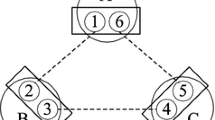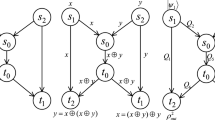Abstract
In order to realize long-distance and large-scale quantum communication, it is natural to utilize quantum repeater. For a general quantum multiple-unicast network, it is still puzzling how to complete communication tasks perfectly with less resources such as registers. In this paper, we solve this problem. By applying quantum repeaters to multiple-unicast communication problem, we give encoding–decoding schemes for source nodes, internal ones and target ones, respectively. Source-target nodes share EPR pairs by using our encoding–decoding schemes over quantum multiple-unicast network. Furthermore, quantum communication can be accomplished perfectly via teleportation. Compared with existed schemes, our schemes can reduce resource consumption and realize long-distance transmission of quantum information.










Similar content being viewed by others
References
Ahlswede, R., Cai, N., Li, S.-Y.R., Yeunget, R.W.: Network information flow. IEEE Trans. Inf. Theory 46, 1204–1216 (2000)
Wootters, W.K., Zurek, W.H.: A single quantum cannot be cloned. Nature 299, 802–803 (1982)
Hayashi, M., Iwama, K., Nishimura, H., Raymond, R., Yamashita, S.: 24th International Symposium on Theoretical Aspects of Computer Science(STACS2007). Springer, Berlin (2007)
Iwama, K., Nishimura, H., Raymond, R., Yamashita, S.: e-print arXiv:quant-ph/0611039
Hayashi, M.: Prior entanglement between senders enables perfect quantum network coding with modification. Phys. Rev. A 76, 040301(R) (2007)
Leung, D., Oppenheim, J., Winter, A.: Quantum network communication-the butterfly and beyond. IEEE Trans. Inf. Theory 56, 3478–3490 (2010)
Satoh, T., Le Gall, F., Imai, H.: Quantum network coding for quatum repeaters. Phys. Rev. A 86, 032331 (2012)
Li, J., Chen, X.B., Sun, X.M., Li, Z.P., Yang, Y.X.: Quantum network coding for multi-unicast problem based on 2D and 3D cluster states. Sci. China. Inf. Sci. https://doi.org/10.1007/s11432-016-5539-3
Kobayashi, H., Le Gall, F., Nishimura, H., Röetteler, M.: General scheme for perfect quantum network coding with free classical communication. LNCS 5555, 622–633 (2009)
Kobayashi, H., Le Gall, F., Nishimura, H., Röetteler, M.: Perfect quantum network communication protocol based on classical network coding. In: Proceedings IEEE International Symposium on Information Theory (ISIT 2010), Austin, TX, USA (2010). https://doi.org/10.1109/ISIT.2010.5513644
Shang, T., Li, J., Pei, Z., Liu, J.W.: Quantum network coding for general repeater networks. Quantum Inf Process 14, 3533 (2015). https://doi.org/10.1007/s11128-015-1066-1
Shang, T., Li, J., Liu, J.W.: Secure quantum network coding for controlled repeater networks. Quantum Inf Process 15, 2937 (2016). https://doi.org/10.1007/s11128-016-1323-y
Nielsen, M.A., Chuang, I.L.: Quantum Computation and Quantum Information, 10th edn. Cambridge University Press, New York (2010)
Briegel, H.-J., Dür, W., Cirac, J.I., Zoller, P.: Quantum repeaters: the role of imperfect local operations in quantum communication. Phys. Rev. Lett. 81, 5932 (1998)
Dür, W., Briegel, H.J.: Entanglement purification and quantum error correction. Rep. Prog. Phys. 70, 1381 (2007)
Van Meter, R., Ladd, T.D., Munro, W.J., Nemoto, K.: System design for a long-line quantum repeater. IEEE ACM Trans. Netw. 17, 1002 (2009)
Jiang, L., Taylor, J.M., Nemoto, K., Munro, W.J., Van Meter, R., Lukin, M.D.: Quantum repeater with encoding. Phys. Rev. A 79, 032325 (2009)
Munro, W.J., Harrison, K.A., Stephens, A.M., Devitt, S.J., Nemoto, K.: From quantum multiplexing to high-performance quantum networking. Nat. Photon. 4, 792 (2010)
Fowler, A.G., Wang, D.S., Hill, C.D., Ladd, T.D., Van Meter, R., Hollenberg, L.C.L.: Surface code quantum communication. Phys. Rev. Lett. 104, 180503 (2010)
Zukowski, M., Zeilinger, A., Horne, M.A., Ekert, A.K.: “Event-ready-detectors” Bell experiment via entanglement swapping. Phys. Rev. Lett. 71, 4287 (1993)
Duan, L.-M., Monroe, C.: Colloquium: quantum networks with trapped ions. Rev. Mod. Phys. 82, 1209 (2010)
Hucul, D., Inlek, I.V., Vittorini, G., Crocker, C., Debnath, S., Clark, S.M., Monroe, C.: Modular entanglement of atomic qubits using photons and phonons. Nat. Phys. 11, 37 (2014)
Van Meter, R., Satoh, T., Ladd, T.D., Munro, W.J., Nemoto, K.: Path selection for quantum repeater networks. Netw. Sci. 3(1–4), 82–95 (2013)
Jones, C., Kim, D., Rakher, M.T., Kwiat, P.G., Ladd, T.D.: Design and analysis of communication protocols for quantum repeater networks. New J. Phys. 18(8), 083015 (2016)
Takahiko, S., Kaori, I., Shota, N., Rodney, V.M.: Analysis of quantum network coding for realistic repeater networks. Phys. Rev. A 93, 032302 (2016)
Acknowledgements
This work is supported by NSFC (Grant nos. 61671082, 61672110, 61572081) and D.-D. Li is also supported by BUPT Excellent Ph.D. Students Foundation (Grant. no. CX2016401).
Author information
Authors and Affiliations
Corresponding author
Appendix
Appendix
1.1 The proof of Theorem 1
Proof
Based on the procedure of \(\text {Con}^{A_{1}}_{A_{2}\rightarrow A_{2}^{'},\ldots ,A_{m}\rightarrow A_{m}^{'}}\), we give the result step by step.
Step 1, u applies \(\text {CNOT}(A_{1},A_{2})\otimes ...\otimes \text {CNOT}(A_{1},A_{m})\) to the state \(|{\varPhi }_\mathrm{init}\rangle \), then
Step 2, u measures \(A_{2},\ldots ,A_{m}\) in the basis \(\{|0\rangle ,|1\rangle \}\), let measurement result be \(\alpha =(a_{2},a_{3},\ldots ,a_{m})\), \( a_{i}\in \{0,1\}\), then
where \(A_{2},\ldots ,A_{m}\) are disregarded since they are not entangled anymore.
Step 3, u applies \(I^{\otimes ^{2}}\otimes ^{m}_{i=2}X^{a_{i}}\otimes I\) to \(|{\varPsi }_{2}\rangle \), then
\(\square \)
1.2 The proof of Theorem 2
Proof
Based on procedure of \(\text {Con}^{B^{'}_{1},\ldots ,B^{'}_{m}}_{C_{1}\rightarrow C^{'}_{1},\ldots ,C_{n}\rightarrow C^{'}_{n}}\) over the states of the internal nodes, we give the result step by step.
Step 1, u applies \(\text {CNOT}(B^{'}_{1}\oplus ...\oplus B^{'}_{m}, C_{1}) ,\ldots ,\text {CNOT}(B^{'}_{1}\oplus ...\oplus B^{'}_{m}, C_{n})\) to \(|{\varPsi }_\mathrm{init}\rangle \); then
Step 2, u measures \(C_{1},\ldots ,C_{n}\) in the basis \({\{|0\rangle ,|1\rangle \}}\), if measurement result \(\beta =(\beta _{1},\ldots ,\beta _{n}),\beta _{i}\in \{0,1\}\), the state becomes
Step 3, u applies \(I^{\otimes m}\otimes ^{n}_{i=2}X^{\beta _{i}}\otimes I\) to \(|{\varPsi }_{2}\rangle \), then
\(\square \)
1.3 The proof of Theorem 4
Proof
Based on procedure of \(\text {Delete} C^{'}_{i}\rightarrow {B^{'}_{1},\ldots ,B^{'}_{m}}\), we give the conclusion step by step.
Step 1, u applies Hadamard operator to \(C^{'}_{i}\) ; then,
Step 2, u measures \(C^{'}_{i}\) in the basis \({\{|0\rangle ,|1\rangle \}}\),
when \(a=0\), the result is
when \(a=1\), the result is
Step 3, if \(a=1\), then u applies \(Z^{\otimes m}\otimes I\) to \(|{\varPsi }_{2_{1}}\rangle \), we get
\(C^{'}_{i}\) can be disregarded because it is not entangled anymore. \(\square \)
Rights and permissions
About this article
Cite this article
Li, DD., Gao, F., Qin, SJ. et al. Perfect quantum multiple-unicast network coding protocol. Quantum Inf Process 17, 13 (2018). https://doi.org/10.1007/s11128-017-1781-x
Received:
Accepted:
Published:
DOI: https://doi.org/10.1007/s11128-017-1781-x




